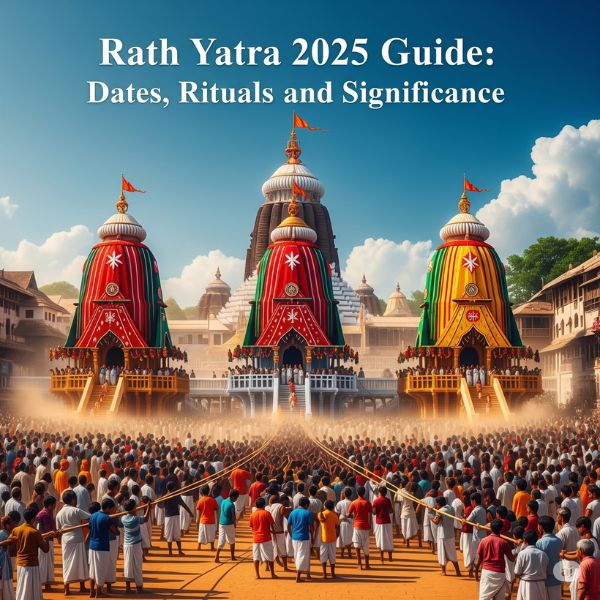Rath Yatra 2025 Guide: Dates, Rituals, and Significance

The Jagannath Rath Yatra, or “Jagannath Puri Yatra”, is the biggest and most auspicious festival of India. This fair is held every year in Puri, Odisha in honour of Lord Jagannath, who is a form of Lord Vishnu along with his elder brother Balabhadra and sister Subhadra, who are also worshipped.
From all over the world, devotees, visitors, tourists and pilgrims flock to the massive procession of the deities hauled in gigantic, intricately carved chariots. The Rath Yatra is also about unity, surrender and life moving forward.
The 2025 Rath Yatra in Puri is a spectacle of rituals, songs, dances, food, and people travelling together and catching up. The Rath Yatra is a reflection of the spiritual and religious zeal of people of Odisha which also brings in the cultural tourism for the state.
This is a journey that every spiritual seeker, pilgrim and culture seeker should make, plan and for and understand the relevance of. The Rath Yatra of Puri 2025 is one of the most celebrated events, and this blog will provide you with all the information about this Festival.
What is Rath Yatra?
The Rath Yatra entails the chariots carrying the deities of the Jagannath Temple moving to the Gundicha Temple, which is considered to be the aunt’s home. The idols are kept on three enormous, beautifully crafted wooden chariots, raths, which are pulled by several thousand devotees. The chariot pulling form of this is very sacred and people do this to get good results. As per texts such as Skanda Purana, this sojourn is Lord Jagannath’s most important one of his annual twelve outings. Observing the gods on these chariots is considered to be a forgiveness of one’s sins and assures one of achieving mo
ksha or salvation.
In 2025, Rath Yatra will commence on June 27 when Dwitiya Tithi of Shukla Paksha falls in the month of Ashadha and the festival will culminate on July 5 with Bahuda Yatra, its return car festival. The festival has a unique feature in that a commoner can participate in pulling the chariots, even the ropes and get a glimpse of the deities and receive their blessings since the Lord of the Universe is considered one!
The Religious Story of Rath Yatra 2025
The Rath Yatra is more than a mere religious event; it is a potent manifestation of divine love, belief and adoration and that is the reason why it has so much spiritual significance.
The symbolism of Lord Jagannath’s Journey:
The chariot procession is a broad symbol for the life journey. The motion of the chariots mirrors the highs and lows, the births and deaths we all go through in life. To followers, it is a teaching that spiritual development requires dedication, hard work and humility.
Unity and Equality:
Unity and equality are the foremost messages to be given by the Rath Yatra. All kinds of people, rich and poor, religious and atheist — come together to pull the chariots in a sign of humanity’s united spirit outstripping differences. This pluralistic view is in essence the nature of Hinduism to bring harmony to all mankind.
Devotion to the Divine:
Being a part of the Rath Yatra allows the devotees to express their unshaken faith in Lord Jagannath. Drawing the chariots is considered a form of devotion, a good omen, and purification of the soul, and is believed to lead one to heaven.
A Call from the Divine:
The festival is regarded as a divine invitation from Lord Jagannath to his devotees to come closer to the sacred. It acts as a spiritual note that the divine presence is eternally close and ready to bless those who sincerely seek it.
Date and Duration of Puri Rath Yatra 2025
Jagannath Rath Yatra 2025 date will start on the 27th of June 2025 and will end on the 5th of July 2025. The Festival of nine days features various special rituals culminating in the world-famous Rath Yatra or the Chariot Festival on the ninth day and the return journey of the deities in their respective chariots to the temple.
Rituals and Dates of Puri Rath Yatra 2025
Snana Purnima – June 12, 2025
Anavasara – June 13 – 26, 2025
Gundicha Marjana – 26 June, 2025
Rath Yatra – 27 June, 2025
Hera Panchami – 1 July, 2025
Bahuda Yatra – 4 July, 2025
Suna Besha – 5 July, 2025
Niladri Bijay – 5 July, 2025
Rituals Observed During Rath Yatra
Rath Yatra Highlights: On the second day of Ashadh Shukla, morning rituals take place, which include Mangal Aarti, Abakash, Khichdi Bhog etc. Subsequent to this is the Managalarpana Ritual where the four gods are brought out by a grand procession and installed in their chariots.
Chhera Panhara
After the gods are seated, the Chhera Panhara ceremony takes place. The Gajapati King of Puri, who is treated as the first and foremost servitor of Lord Jagannath, also comes out in the royal procession (Shree Angan) from his royal palace. He then offers aarti with camphor from a golden lamp, waves it and then sweeps the chariots with a golden broom to dismantle hypocrisy, and sprinkles sandalwood water which is considered a purification and cleaning agent.
Pulling the Chariots
After the Cutting of the Chhera Panhara, four wooden horses are attached to the chariots. The Yatra is heralded by the blowing of a conch by the servitor from Kahala. These huge chariots are then pulled through the streets by devotees while singing, music and celebration takes over them.
Hera Panchami
On the 5th day of the Rath Yatra (journey of chariots), the Hera Panchami is celebrated as the deities remain at the Gundicha Temple. The goddess Mahalaxmi (the consort of Lord Jagannath) is furious for her husband having left her behind and follows him.” She too does not stay idle and rushes to Gundicha Temple in a palanquin and desires that her husband return to her soon. Lord Jagannath gives her a garland called “again mala” to calm her. If dissatisfied, they close the main gate of the Gundicha Temple. Receiving the wreath, she comes back to the main temple via the Nakachana gate and watches secretly from behind a tamarind tree and re-enters peaceably by Hera Gohri Lane. In this same process, she instructs one servant of hers to break a portion of Nandighosa’s chariot.
Bahuda Yatra
After nine days, the gods commence their homeward journey, known as Bahuda Yatra or Dakshinabhimukhi Yatra. Chariot is then pulled back to the Jagannath Temple with great enthusiasm by the devotees. En route, the chariots halt at the Mausi Maa Temple and the deities are offered Poda Pitha, a special type of baked cake which is exclusively prepared on this occasion.
Niladri Bije
The festival ends with Niladri Bije on the 13th day of Ashadha Shukla. The four gods go to their lair in a glorious and happy parade, signifying their completion of the divine visit. The Shree Jagannath Yatra is one of the oldest and widely celebrated religious festivals around the world, giving religious significance with traditional observance and devotion.
Conclusion
For us, Rath Yatra is more than a religious festival, it runs in our veins, it is the way of our life, our culture and our tradition, which has been nurtured over generations and will continue to prosper in the time to come. It is an opportunity to meet, if not often enough, members who share our blood and our beliefs.
In the backdrop of the grand chariots rolling past, they offer us that enduring insight to the eternal principles that unite us, that of love, kindness, and faith. This is a festival that allows us to plug into something much greater than ourselves, to exist as part of a timeless sacred ritual.
The Rath Yatra is a strange reflection of the depth of Indian spiritualism and the cultural bounty of the land. What this illustrates is that whatever our race and origin, we are all of a shared being that goes beyond our personal selves.
